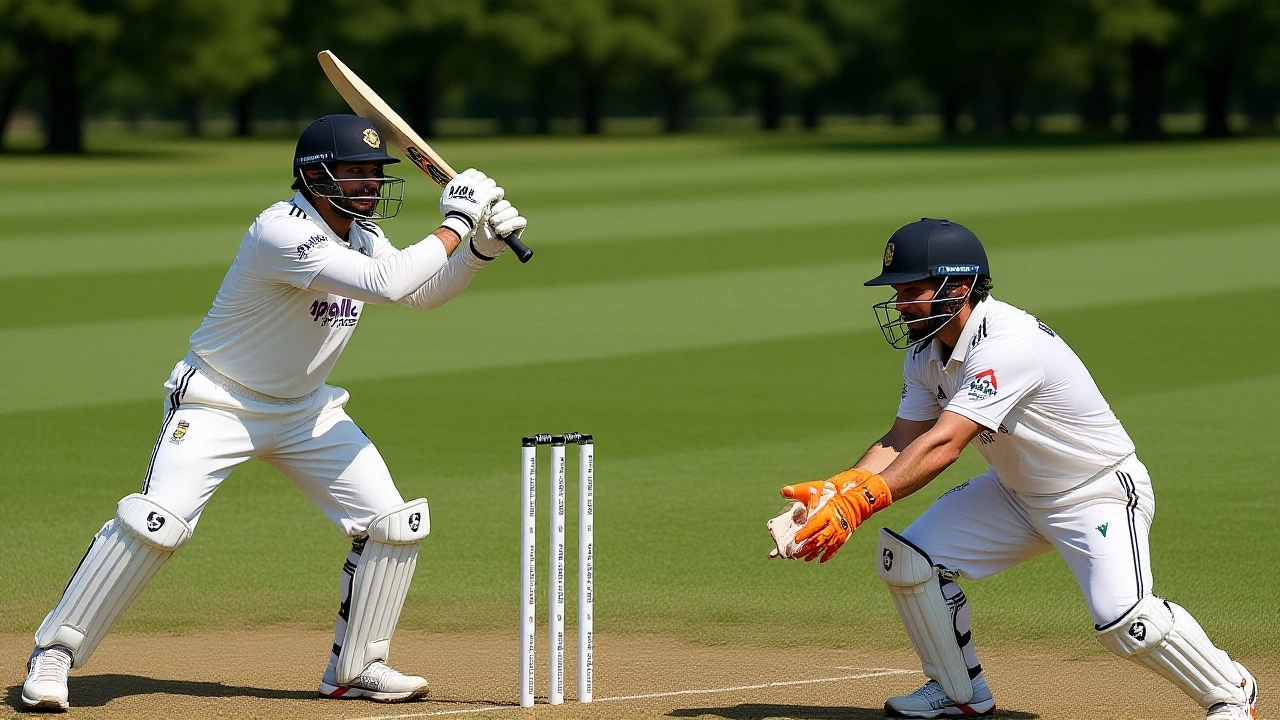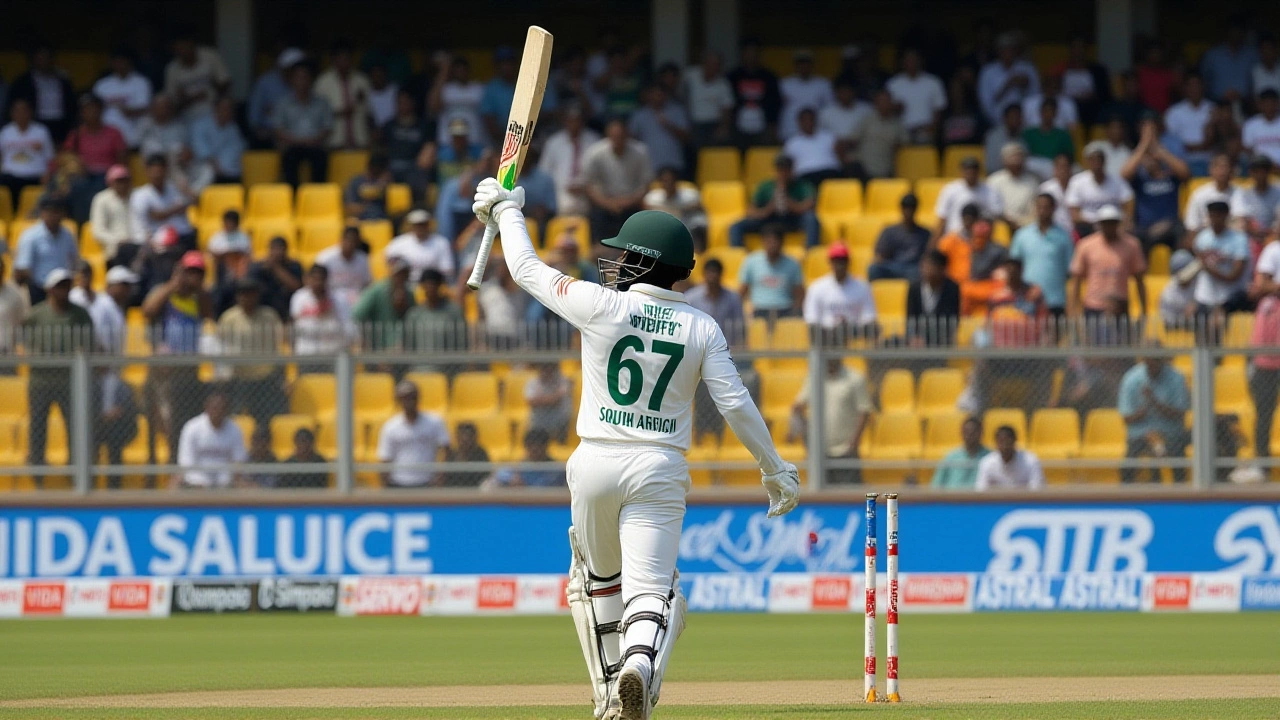 Nov, 24 2025
Nov, 24 2025
On Day 3 of the second Test in Guwahati, South Africa didn’t just take control — they dismantled India’s resistance, finishing the day at 26/0 in their second innings with a commanding 314-run lead. The Barsapara Cricket Stadium in Guwahati, Assam, was a silent witness to one of the most one-sided days in recent Test cricket history. India, bowled out for 201 in their first innings, now face a near-impossible task: survive two more days and then bowl out South Africa twice to win. The twist? South Africa’s captain, Temba Bavuma, chose not to enforce the follow-on — not out of mercy, but strategy. He wanted his bowlers rested, and his batters to keep building pressure. It’s working.
How South Africa Broke India’s Backbone
It started with Marco Jansen. The 6-foot-6 fast bowler didn’t just take wickets — he shattered confidence. His 6 for 48 wasn’t just numbers; it was a masterclass in seam movement and relentless pressure. He dismissed Jasprit Bumrah with a sharp inswinger caught by Kyle Verreynne, and then came the bizarre moment: Ravindra Jadeja was run out after a miscommunication with Washington Sundar — no run, no appeal, just a stunned silence. The Indian dressing room looked like a team that had forgotten how to play Test cricket.India’s top order, which had looked promising on Day 2, imploded. Yashasvi Jaiswal, who’d finally cracked a fifty in seven innings (85 balls), fell to Simon Harmer with a lazy drive to short third. That wicket triggered a chain reaction. KL Rahul (22) fell to Keshav Maharaj, Dhruv Jurel and Rishabh Pant played reckless shots that screamed panic. The Indian cricket team didn’t just lose wickets — they lost their minds.
Senuran Muthusamy’s Redemption Arc
While Jansen terrorized the batting, Senuran Muthusamy — the South African all-rounder of Indian descent — wrote his own fairy tale. Coming in at 201/5, he played the innings of his life: 109 off 206 balls. For context, Muthusamy had been written off after his 2019 debut series in India, where he managed just two wickets and looked out of his depth. Now, he’d not only cracked the subcontinent code but had become the backbone of South Africa’s 489. His 89 not out in Pakistan earlier this year had been a sign — this was confirmation. He didn’t just score runs; he reminded everyone that cricket is a game of second chances.And then there was Jansen’s 93 — aggressive, fearless, almost disrespectful to the Indian attack. Together, Muthusamy and Jansen added 175 runs for the seventh wicket. It was the kind of partnership that turns matches. When South Africa declared at 489, it wasn’t a statement — it was a verdict.
Why Not Enforce the Follow-On?
It’s the question everyone’s asking. Why let India bat again? Simple: fatigue. South Africa’s pacers had bowled 151.1 overs in their first innings. The sun was brutal. The pitch was drying. Temba Bavuma knew that if he bowled India out again on Day 3, his bowlers would be spent by Day 4. Better to bat again, pile on the runs, and then let the pitch do the rest. As India Today reported, "The pacers will be given some time to rest as the light meters come out." It wasn’t just about tactics — it was about psychology. South Africa was playing for the long game.
India’s Crisis of Identity
This isn’t just about losing a Test. It’s about what’s broken beneath the surface. India have lost two of their last three home Test series. Their middle order — once a strength — is now a liability. Washington Sundar (48) was the only one who looked like he belonged. Kuldeep Yadav (14*) and Mohammed Siraj didn’t even get to face more than a handful of balls. The Indian batting lineup has no structure, no patience, no plan. The Indian Express called it "wilted minds, hands and feet." And they weren’t wrong.On Day 2, India had started at 9/0, still trailing by 480 runs. On Day 3, they were all out for 201. That’s not bad luck. That’s systemic failure. The team’s leadership — Rishabh Pant in the absence of Rohit Sharma — is under fire. His 11 off 32 balls? A microcosm of the problem: too slow when they needed to fight, too reckless when they needed to survive.
What Happens Next?
South Africa resumes on Day 4 at 26/0, with Ryan Rickelton (13*) and Aiden Markram (12*) at the crease. If they add another 100, the match is effectively over. India will need to bat for over 180 overs — more than three full days’ worth — just to draw. To win? They’ll need a miracle. And a miracle is exactly what they don’t have.Bad light has already cut play twice on Day 3. With only two full days left — November 25 and 26 — and the pitch offering more turn and uneven bounce, South Africa’s spinners, especially Keshav Maharaj and Simon Harmer, will have the upper hand. India’s spinners? They’ve been hit for runs and taken just one wicket between them.

Historical Echoes
This isn’t the first time India has collapsed in a home Test. Remember 2021, when Australia won by an innings in Adelaide? Or 2023, when England won by 146 runs in Delhi? But those were against top-tier teams. This? This is against a South African side that, until recently, struggled to win overseas. Now, they’re playing like champions. And India? They’re playing like a team that’s lost its way.Frequently Asked Questions
How big is South Africa’s lead, and what does it mean for India’s chances?
South Africa leads by 314 runs after bowling India out for 201 and reaching 26/0 in their second innings. For India to win, they’d need to survive over 180 overs in their second innings, then bowl South Africa out twice — a feat only achieved 12 times in Test history, and never by a team trailing by more than 250 runs. The odds are near-zero.
Why did Temba Bavuma choose not to enforce the follow-on?
Bavuma prioritized bowler fatigue over immediate pressure. South Africa’s pacers had bowled 151 overs in the first innings, and the Guwahati heat was draining. By batting again, they extended their lead, protected their bowlers, and set up a scenario where India’s spinners would face a tired, worn pitch — maximizing South Africa’s chances of a win.
What made Marco Jansen’s performance so exceptional?
Jansen’s 6/48 included the key wickets of Bumrah and Jadeja, and his pace and seam movement exploited India’s poor footwork. His ability to swing the ball both ways on a pitch offering little assistance made his figures even more impressive. He also contributed 93 runs with the bat — the rare all-rounder who dominates both departments.
How has Senuran Muthusamy transformed since his 2019 debut in India?
After taking just two wickets in two Tests during his 2019 debut series in India, Muthusamy was nearly dropped. But he rebuilt his game, focusing on subcontinental conditions. His 11-wicket haul in Pakistan earlier in 2025 and now this 109 in Guwahati prove he’s mastered the art of patience and placement on turning tracks — turning his career around completely.
What’s the biggest concern for India’s batting lineup?
The middle order — Jurel, Pant, Jadeja, Reddy — has no consistency or adaptability. They’re either too defensive or too reckless. Against quality pace and spin, they lack the technical discipline to survive. With no clear hierarchy or plan, India’s batting looks fragmented, not functional.
Can India still save the match?
Technically, yes — but realistically, no. Even if India survives Day 4 and 5, they’d need to bowl South Africa out for under 200 in their second innings, then chase 515+ in under 100 overs. No team has ever chased more than 418 in the fourth innings of a Test. The math doesn’t work. A draw is the only realistic outcome now.